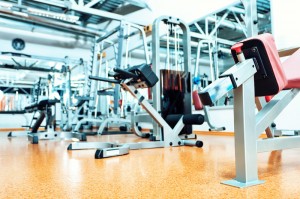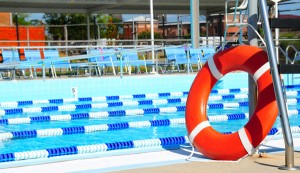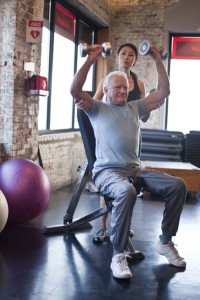 Chuck Hall looks out the office window overlooking his Arnold, Md. facility. “I’m constantly thinking about how our members can be safe,” said Hall, the executive director of Big Vanilla. “By the time members park on the parking lot, from the pathways and walkways, to anywhere in your club — you could be liable. Liability is constant work.”
Chuck Hall looks out the office window overlooking his Arnold, Md. facility. “I’m constantly thinking about how our members can be safe,” said Hall, the executive director of Big Vanilla. “By the time members park on the parking lot, from the pathways and walkways, to anywhere in your club — you could be liable. Liability is constant work.”
As a club owner, it’s important that your members are safe. The potential is always present for a member to get hurt in your facility. Although, it would be ideal if these situations didn’t happen, injuries are a common occurrence in fitness-related activities. The following scenarios describe what could happen in your club, and our experts help you resolve the issue.
SCENARIO ONE
It’s the middle of summer, and members have flocked to your outdoor pool to escape the heat. Children, wrapped up in the excitement of play, start to run and one slips, breaking an arm.
During the summer at Big Vanilla, pools become the center for the local community. “We’re a community-oriented facility,” said Hall. As a result, there are often multiple members, and many children on the premise.
According to Jennifer Urmston Lowe, the national account manager for Sports & Fitness Insurance Corp., one of the top areas in which insurance companies see claims is the pool, and other wet areas.
To ensure its members are being safe when using the pool amenities, Big Vanilla has a lifeguard on duty at all times. Signs are on display stating the rules in both the pool area and in multiple areas of the club — including the locker rooms. When members sign up, they are also verbally described the rules in order to further enforce club policy.
“A lot of clubs make the mistake of not having written rules or guidelines,” said Ken Reinig, the president of Reinig Insurance Solutions. “Establishing a set of club policies and guidelines that outline the do’s and don’ts for members and overall facility safety can help limit liability,” he explained. According to Reinig, not having policies can be a huge mistake — having them shows you have taken steps to consider the safety of your members.

Sometimes children, and even seasoned members have trouble following the rules, which can lead to accidents. Reinig recommended that clubs have a three strike and you’re out rule. During the first strike, give them a verbal warning; the second, a written warning — if you need to give a member a third, you may want to consider discontinuing their membership. “Don’t be afraid to kick out members who pose a risk,” explained Reinig.
Members who exhibit dangerous or reckless behavior not only pose a risk to the club, but to other members as well, which may drive away your clientele. Keep the members who follow the rules, and think about getting rid of the ones that don’t. By doing so, you’ll have an overall better club environment and be exhibiting proper risk management.
SCENARIO TWO
A member is using a piece of strength equipment incorrectly, by modifying it to fit their workout. A staff member sees this, but doesn’t approach the member in fear they’ll disturb or offend them. As a result, that member gets injured.
“The biggest mistake clubs make is assuming something won’t go wrong,” said Hall. As a result, club employees must be proactive in stopping members from engaging in dangerous behaviors. “You can’t have a ‘do it later approach,’” said Hall. “It must be a ‘do it now approach.’”
However, where many clubs face issues with this scenario, is employing staff members that are afraid to enforce the club’s policies and guidelines. Approaching a member can sometimes be intimidating to employees who don’t want to disturb members’ workouts, or come off as rude. “The staff member should definitely offer the member assistance to help them use the equipment properly,” said Lowe. “If they are not comfortable approaching the member, then they should advise the manager, so that the manager can assist the member,” she said.
In this situation, training your staff is a must — if your employees don’t know how to properly use the equipment, they’re not going to be able to tell if a member is not. At Big Vanilla, Hall continually sends out memos and pushes his staff to read articles on limiting liability. “Proactively talk with your general managers and staff on how to limit liability,” he said.
“Train your employees!” emphasized Lowe. “Teach them how to demonstrate to use the equipment, and teach them how to maintain it.”
One of your members is experiencing chest pain after a group fitness class — they suddenly collapse and experience a cardiac event. Frantically, you search for an Automated External Defibrillator (AED) — studies show that defibrillation within the first five minutes of cardiac arrest can improve the chance of survival of that member by 90 percent.
According to Paul LeBlanc, the owner of Zogics, LLC, the risk of a cardiac event is as much as 15-20 times higher during, or immediately following, vigorous exercise. With this knowledge, Anytime Fitness recently required that all of its locations have at least one AED — a decision that could reduce the club’s liability if a member were to have a cardiac event, such as a heart attack.
“Your members’ safety is the number one priority,” said Hayes Carter, an Anytime Fitness franchisee. “I think it’s a good requirement to have — it shows that you care.” At Carter’s Anytime Fitness location, all employees are trained to use the defibrillator, and all club managers are CPR and AED certified. “So far I haven’t had to use it, but it’s definitely a valuable asset to the club,” said Carter.
According to LeBlanc, having first-aid kits, AEDs, and other health-related products show that you’re concerned about members’ safety and are prepared in case something does go amiss. “Perception can play a significant role in reducing risk and liability, so it’s important to make sure your members know their safety is your primary concern,” said LeBlanc. “Is your AED displayed prominently for all to see? Is your first-aid kit fully stocked and easily accessible? If a member required a simple bandage and you’re out, it sends the message that you’re not prepared and don’t care.”
SCENARIO FOUR
A member is running on the treadmill, and steps off to grab a towel or water while leaving the treadmill running. Another member steps on the belt and is immediately catapulted off the back, resulting in an injury.
According to Reinig, this is a common liability scenario that is a direct result of a “Member Malfunction.” “In other words, the member has hurt themselves or another member without any negligence on the part of the club — usually due to not paying attention to what they are doing — losing their balance, dropping weights, tripping while on a treadmill, etc.,” explained Reinig.
A way to limit liability during a “Member Malfunction” scenario is to have a waiver/hold harmless agreement that is separate from the membership agreement. “[This] provides the best tool for defending the club,” said Reinig. “Most clubs have their waivers in their membership agreement — they try to do way too much in such a short document.” Reinig recommended that clubs have a separate page, and most importantly, a second signature for their waiver form. If clubs don’t, they could be targeted for liability.

At Results Fitness in Newhall, Calif., each member works closely with a staff member to make sure they’re properly oriented in how to use the equipment. “All of our members work with a coach in our system, which is an individualized program designed for the client,” explained Rachel Cosgrove, the owner of Results Fitness. “Having a smart training system in place is part of our strategy. In addition, we are constantly working on improving our customer service, building relationships with our clients and truly caring about them as people.”
“Friends don’t sue friends,” said Reinig. “It’s like when you go to your favorite bar or restaurant, if you’ve developed a good friendship with your member, if that person felt like they’re a family member of the gym, the likelihood of them contacting an attorney goes down.”
Along with building good relationships with members, check with your insurance company and make sure that your club is up to date on state guidelines and safety procedures. Such as the case with Hall, the safety of your members should be at the forefront of your mind at all times — constant vigilance could be the way to help avoid these common liability scenarios.
“Any of these instances could be avoided with a simple system put into place for the team to follow a checks and balances, or standard operating procedure of making sure that you are always providing a safe, clean and comfortable environment for your members to train in,” said Cosgrove.
By Rachel Zabonick











